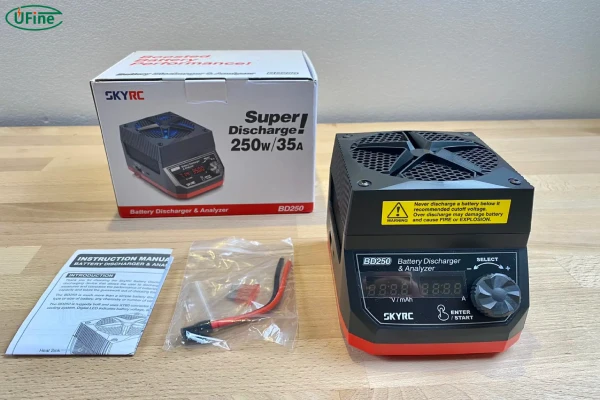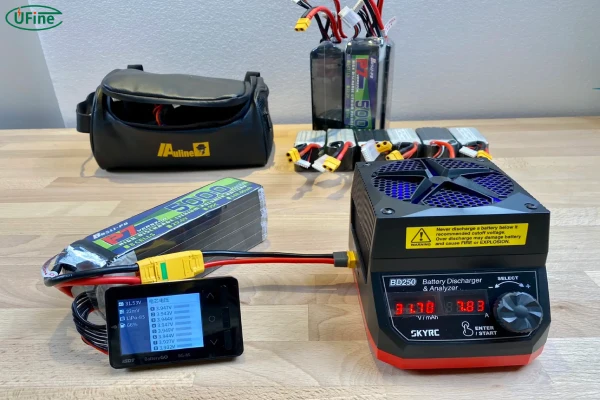Part 1. What is a lipo battery discharger?

If you’re into drones, RC vehicles, or anything powered by lithium polymer (lipo) batteries, you’ve probably heard about lipo battery dischargers. But what exactly are they, and why are they so important?
A lipo battery discharger is a handy tool that helps reduce the charge in your lipo batteries to a specific, safer level. These devices are designed to keep your batteries in top shape by managing their charge levels, especially when you’re not using them for extended periods. Unlike regular chargers, dischargers focus on safely removing excess power, preventing battery damage, and ensuring longer life.
Lipo batteries are known for their incredible power density and lightweight build, but they’re also quite sensitive. If left fully charged for too long or discharged improperly, they can swell, overheat, or even catch fire. That’s where a good lipo battery discharger steps in — it’s your safety net and performance booster.
Part 2. Basic components
Let’s break down what makes a lipo battery discharger tick. These devices might seem simple, but they pack some essential components that work together to get the job done.
- Discharge Circuit: The heart of the discharger, this regulates the flow of current to prevent over-discharging.
- Cooling Fan: Keeps the device from overheating during operation, especially at higher discharge rates.
- Heat Sink: Aids in dissipating heat efficiently for better performance.
- Voltage Monitor: Tracks the battery’s voltage in real-time, ensuring it doesn’t drop below safe levels.
- Display Screen: Provides critical data like voltage, current, and discharge progress.
- Control Buttons or Dials: Let you customize settings such as discharge rate and cutoff voltage.
- Input and Output Ports: For connecting your battery and power source.
These components work together seamlessly to ensure your batteries are discharged efficiently and safely. It’s amazing how much engineering goes into something that looks so compact!
Part 3. What is the use of a lipo battery discharger?
You might be wondering, “Why do I even need this gadget?” The truth is, a lipo battery discharger is a multi-functional tool that can make your life so much easier if you work with lipo batteries often.
Here are some key uses:
- Storage Preparation: Dischargers bring your battery down to its optimal storage voltage, preventing swelling and degradation.
- Performance Checks: Test your battery’s capacity and health by seeing how much energy it can store and release.
- Balancing Cells: Ensure all cells in a battery pack have equal charge levels, which improves performance and lifespan.
- Safety: Discharging reduces the risk of overheating and potential fire hazards.
- Recycling: Batteries must be fully discharged before disposal to avoid environmental hazards.
In short, a lipo battery discharger is like a personal trainer for your batteries, keeping them healthy and ready for action.
Part 4. Why does a lipo battery need to be discharged?
Here’s where things get serious. Lipo batteries are incredible but also temperamental. Without proper discharge, they can lose capacity, overheat, or even pose safety risks.
Reasons to Discharge:
- Storage Safety: Storing a fully charged lipo battery for too long can lead to swelling and chemical instability.
- Optimize Lifespan: Regular discharging prevents the battery from developing a “memory effect” and ensures longer usability.
- Prevent Overcharging: If a battery is left charged beyond its limit, its internal chemistry deteriorates faster.
- Prepare for Disposal: Fully discharging a battery before disposal reduces environmental and safety hazards.
By making discharging a routine part of your battery care, you can extend its life and save yourself from unexpected problems.
Part 5. Types of lipo battery dischargers
Now, let’s explore the different types of lipo battery dischargers and find out which one suits your needs best.
- Manual Dischargers: Basic and budget-friendly, but they require constant monitoring.
- Automatic Dischargers: Smart tools that adjust settings and stop automatically when the battery reaches the desired voltage.
- Combination Chargers/Dischargers: Ideal for multitaskers, these devices charge and discharge in one unit.
- High-Power Dischargers: Designed for larger batteries, these handle higher voltages and currents.
- Storage Dischargers: Specialized for bringing batteries to their storage voltage quickly and accurately.
Part 6. How to use a lipo battery discharger?
Using a lipo battery discharger might seem intimidating at first, but it’s easier than you think. Here’s a step-by-step guide:
- Connect Your Battery: Attach the battery to the discharger’s input port securely.
- Set the Parameters: Adjust settings like discharge rate and target voltage. Check the manual for your specific device.
- Start Discharging: Turn on the discharger and monitor its progress on the display screen.
- Stop When Done: Most automatic dischargers will stop on their own, but manual ones require you to watch closely.
- Store Properly: Once discharged, store your battery in a cool, dry place.
Pro Tip: Always keep an eye on the process, especially if you’re using a manual discharger. Safety first!
Part 7. Important parameters of lipo battery dischargers
Choosing the right lipo battery discharger can be daunting. Here are some key parameters to focus on:
- Discharge Rate: Higher rates are great for quick results but may generate more heat.
- Voltage Range: Ensure compatibility with your battery’s voltage.
- Thermal Management: Look for devices with heat sinks and cooling fans.
- Portability: A compact and lightweight device is easier to carry.
- Ease of Use: Intuitive controls and a clear display make a world of difference.
Part 8. Precautions
Handling lipo battery dischargers requires some care. Keep these precautions in mind:
- Avoid Over-Discharging: This can permanently damage your battery.
- Stay Alert: Never leave the discharger unattended while in use.
- Ensure Ventilation: Use the device in a well-ventilated area to prevent overheating.
- Regular Inspections: Check your discharger and batteries for any signs of damage before use.
Part 9. Faults and troubleshooting
Even the best devices encounter hiccups. Here are some common issues and how to fix them:
-
Device Overheating
- Cause: Prolonged use or insufficient cooling.
- Solution: Use in short bursts and ensure the fan is working.
-
Inconsistent Readings
- Cause: Calibration errors.
- Solution: Recalibrate or reset the discharger.
-
No Power
- Cause: Loose connections or power supply issues.
- Solution: Double-check all cables and ports.
With the right knowledge and tools, you can keep your lipo batteries in excellent condition. A lipo battery discharger isn’t just an accessory — it’s an investment in your battery’s performance and safety.
Related Tags:
More Articles

How to Choose the Best Floor Scrubber Battery for Commercial Cleaning?
Selecting the ideal floor scrubber battery ensures a long runtime, rapid charging, and minimal maintenance for efficient commercial cleaning operations.
Battery for Blower vs Battery for Leaf Vacuum: Which One Should You Choose?
Battery for blower vs leaf vacuum—learn the key differences in power, fit, and runtime to choose the right battery for your outdoor tool needs.
How to Choose the Right Battery for Blower?
Choosing the right blower battery? Consider voltage, capacity, chemistry & usage. This guide helps match the best battery for peak performance.
How to Choose the Best Insulated Battery Box for Lithium Batteries?
Choosing the Best Insulated Battery Box for Lithium Batteries? Discover key factors such as size, material, and safety for optimal protection and performance.
7 Critical Elements on a Lithium Battery Shipping Label
What must be on a lithium battery shipping label? Learn 7 key elements to ensure safety, legal compliance, and correct handling across all transport modes.




